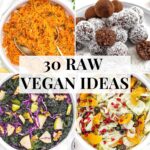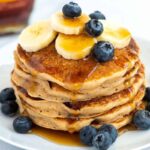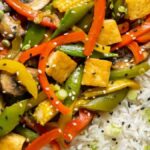Imagine waking to the sun’s gentle kiss, the aroma of crunchy, nutty granola filling your kitchen. This isn’t just any granola; it’s a vibrant symphony of raw, vegan goodness, bursting with the natural sweetness of nuts and seeds. Discover three unique variations—each a testament to the versatility of this healthy breakfast staple—crafted to tantalize your taste buds and nourish your body from the inside out. Prepare to embark on a culinary journey that celebrates the simple elegance of raw, plant-based ingredients, transforming your mornings into a delicious ritual of wellness.
We’ll guide you through the effortless process of creating this superfood, from selecting the perfect nut and seed combinations to mastering the art of drying your granola to achieve that ideal texture. Learn about ingredient substitutions, ensuring you can adapt the recipe to your dietary needs and preferences. Explore creative serving suggestions, transforming your granola into a versatile culinary chameleon that complements yogurt, smoothies, or simply delights as a standalone snack. This isn’t just a recipe; it’s a gateway to a healthier, more vibrant you, one delicious spoonful at a time.
Step-by-Step Preparation Guide

Making raw vegan granola is a wonderfully simple process, allowing you to create a healthy and delicious breakfast treat customized to your taste. This guide will walk you through each step, resulting in a crunchy, satisfying granola perfect for enjoying with your favorite plant-based milk or yogurt.
Basic Raw Vegan Granola Recipe
This recipe provides a foundation for your granola creation. Feel free to adjust the quantities of nuts, seeds, and spices to suit your preferences.
- Combine the Dry Ingredients: Imagine a rustic wooden bowl overflowing with a mixture of golden almonds, plump sunflower seeds, and speckled pumpkin seeds. Carefully measure out 1 cup of almonds, ½ cup sunflower seeds, and ½ cup pumpkin seeds. Add them to the bowl, along with ½ cup shredded coconut, offering a touch of sweet, delicate white against the darker nuts and seeds. Then, gently stir in ¼ cup unsweetened cocoa powder, transforming the mixture into a rich, dark brown hue. The visual effect is striking, showcasing the diverse textures and colors of the ingredients.
- Sweeten and Spice: Now, for the flavor enhancement. Picture a small glass bowl containing a delicate blend of ingredients: ⅓ cup of pitted Medjool dates, their deep brown color contrasting with the bright amber of 2 tablespoons of maple syrup. Add these to the larger bowl, along with a dash of cinnamon (about ½ teaspoon) and a pinch of sea salt. The addition of these ingredients creates a beautifully textured and aromatic blend, ready for the next step.
- Blend the Mixture: Using a high-powered food processor, pulse the ingredients until they are coarsely chopped but still retain some texture. Visualize the food processor whirring, the mixture transforming from a heterogeneous collection of ingredients into a more uniform, yet still visibly textured, mass. Avoid over-processing; you want some larger pieces for that satisfying crunch.
- Optional additions: Enhance the granola with dried fruit, such as cranberries or chopped apricots, or add a handful of goji berries for a vibrant pop of color and a subtle sweetness. A sprinkling of chia seeds or hemp seeds adds extra nutritional value and a slightly earthy flavor. The addition of these ingredients transforms the basic granola into a visually appealing and nutritionally rich mix.
Drying Methods: Air Drying, Dehydrator, and Sun Drying
The drying process is crucial for achieving the desired texture and shelf life of your raw vegan granola. Each method offers unique advantages and disadvantages.
- Air Drying: This method involves spreading the granola in a thin layer on a parchment-lined baking sheet and letting it air dry for several days in a cool, dry place. Imagine the granola, a thin, textured layer, gradually losing its moisture, transforming from slightly sticky to perfectly crunchy. Pros: Simple and requires no special equipment. Cons: Slowest method and susceptible to humidity and potential mold growth if not properly monitored.
- Dehydrator Use: A dehydrator offers a controlled environment for drying the granola, ensuring consistent results. Picture the dehydrator trays neatly filled with the granola mixture, slowly drying to a perfect crispness. Pros: Fastest and most controlled method, producing evenly dried granola. Cons: Requires a dehydrator, which represents an initial investment.
- Sun Drying: Sun drying involves spreading the granola on a screen or tray in direct sunlight. Imagine the granola, basking in the sun’s rays, slowly losing moisture as the warmth gently dries it. Pros: Free and uses natural energy. Cons: Highly dependent on weather conditions; humidity and rain can ruin the granola. Requires careful monitoring to prevent burning or attracting insects.
Tips for Optimal Texture and Avoiding Common Mistakes
Achieving the perfect crunchy granola requires attention to detail.
To ensure optimal texture, avoid over-processing the ingredients in the food processor. A slightly coarse texture is desirable for that satisfying crunch. Also, ensure the granola is spread thinly during the drying process to promote even drying and prevent clumping. Improper drying can lead to a soggy granola, while over-drying may result in a brittle, overly dry product. Maintaining a consistent temperature during dehydrating is crucial for optimal texture. Air drying should be done in a cool, dry, and well-ventilated area.
Ingredient Substitutions and Alternatives
Creating a raw vegan granola offers incredible flexibility. The beauty lies in its adaptability to various dietary needs and preferences, allowing for creative substitutions without compromising the delicious outcome. This section explores suitable alternatives for common ingredients, considering allergies and dietary restrictions, and delves into the impact of different sweeteners on the final product.
Alternative Sweeteners
Three readily available sweeteners can replace maple syrup or other liquid sweeteners in a raw vegan granola recipe: dates, agave nectar, and coconut nectar. Each offers a unique flavor profile and influences the granola’s texture differently. Dates, for instance, add a rich caramel-like sweetness and a slightly chewy texture when blended into a paste. Agave nectar contributes a milder, slightly floral sweetness and keeps the granola relatively crisp. Coconut nectar imparts a subtle coconut flavor and a slightly softer, more moist texture. The choice depends on personal preference and the desired final product characteristics.
Ingredient Substitution Table
| Ingredient | Potential Substitutes | Impact on Granola |
|---|---|---|
| Nuts (almonds, cashews) | Sunflower seeds, pumpkin seeds, pepitas, macadamia nuts, Brazil nuts | Changes the flavor profile and potentially the texture; sunflower and pumpkin seeds offer a slightly earthier taste and a crunchier texture compared to almonds or cashews. Macadamia nuts add richness and creaminess, while Brazil nuts provide a bolder, more intense flavor. |
| Seeds (chia, flax) | Hemp seeds, sesame seeds, sunflower seeds | Alters the nutritional profile and adds varying levels of crunch. Hemp seeds offer a nutty flavor and a slightly softer texture than chia or flax. Sesame seeds add a unique, slightly toasty flavor and a pleasant crunch. |
| Maple Syrup | Dates (pureed), agave nectar, coconut nectar, rice malt syrup | Impacts sweetness and texture. Dates create a chewier granola, agave provides a smooth, slightly less intense sweetness, coconut nectar adds a coconut flavor and potentially a softer texture, while rice malt syrup offers a milder, less complex sweetness than maple syrup. |
| Dried Fruit (raisins, cranberries) | Goji berries, chopped apricots, shredded coconut, chopped dates | Modifies the sweetness, flavor, and texture. Goji berries provide a tart sweetness, apricots add a fruity sweetness and a slightly softer texture, shredded coconut enhances the coconut flavor and adds a slightly chewy element, and chopped dates intensify the caramel-like sweetness and add a chewy texture. |
From the satisfying crunch of perfectly toasted nuts and seeds to the delightful dance of flavors in each bite, this raw vegan granola is more than just breakfast; it’s a testament to the power of simple, wholesome ingredients. We’ve explored the versatility of this recipe, offering variations to suit every palate and dietary need, empowering you to create a personalized morning ritual that nourishes your body and delights your senses. Embrace the ease and joy of crafting this healthy treat, and experience the transformative power of a truly nourishing start to your day. So, gather your ingredients, unleash your creativity, and savor the delicious rewards of a healthy and fulfilling morning.
Commonly Asked Questions
Can I store this granola in the fridge?
Yes, refrigeration will extend the shelf life of your granola, keeping it fresher for longer.
How do I know if my granola has gone bad?
Look for signs of rancidity (off-putting smell or taste), mold, or significant changes in texture. If any of these are present, discard the granola.
What if I’m allergic to nuts?
Several seed-based variations are possible; sunflower, pumpkin, and sesame seeds offer excellent alternatives. Always check labels carefully.
Can I add chocolate chips?
Absolutely! Raw cacao nibs or carob chips are delicious additions, adding a rich chocolatey flavor.


